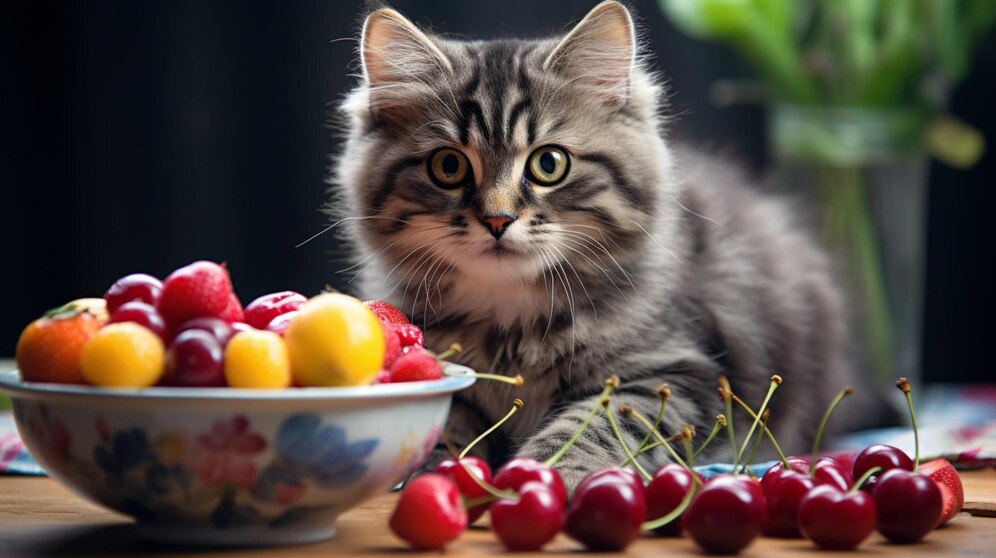Cats don’t like fruits, but what about cherries? Can cats eat cherries?
The answer is no, they can’t have cherries in their diet. The main reason is that cats are carnivores, and their stomachs aren’t built to digest human food easily.
Cherries offer many benefits for humans, such as improving sleep, lowering cancer risk, and helping regulate blood sugar levels but not for our feline friends. But why can’t cats eat cherries? That’s what we’re here to explain today. But you must read most dangrous chocolate and onion first.
Key Takeaways
· Consult your vet as soon as possible if your cat has ingested a cherry for proper medical treatment.
· Don’t try to induce vomiting at home, as it’s not safe.
· Thoroughly clean your cat’s mouth after ingestion to prevent further consumption.
· Don’t punish your cat for ingesting cherries; it will only cause them stress.
Can Cats Eat Cherries?
No, cats cannot eat cherries. Cherries are poisonous to cats. One of the most commonly asked questions is: When does cherry poisoning occur in cats?
Cherry poisoning in cats occurs when they ingest parts of the cherry plant, especially the leaves, stems, and seeds, which contain cyanogenic glycosides. These release cyanide when digested, leading to serious health issues. Some key signs of cherry poisoning in cats include:
- Difficulty breathing
- Dilated pupils
- Bright red gums
- Weakness or lethargy
- Drooling
- Vomiting
- Seizures or tremors
- Shock or collapse
Causes of Cherry Poisoning in Cats
There are many causes of cherry poisoning in cats. Some of them are listed below:
- Ingestion of cherry pits
- Consumption of cherry stems
- Eating cherry leaves
- Exposure to cyanogenic glycosides in cherries
- Chewing on or eating wilted parts of the cherry plant
- Ingestion of unripe cherries
Cyanogenic glycosides, when ingested and broken down in the body, release cyanide. Cyanide binds to a key enzyme in the cells called cytochrome oxidase, which is essential for cellular respiration. This binding prevents the cells from using oxygen effectively, leading to oxygen deficiency. As a result, the cat’s body attempts to compensate by breathing heavily to increase oxygen intake. Read Kidney Disease in Cats: Early Signs You Shouldn’t Ignore
Diagnosis of Cherry Poisoning in Cats
Cherry poisoning in cats can be difficult to diagnose without specific tests. However, if you feel your cat has ingested any part of a cherry plant, it’s important to seek veterinary attention immediately. Your veterinarian may use a combination of tests to diagnose cherry poisoning:
- Physical examination
- Blood tests
- Urine tests
- Cyanide detection tests
Treatment of Cherry Poisoning in Cats
The treatment of cherry poisoning depends on how much of the cherry a cat has ingested. If your cat has recently ingested parts of the cherry plant, your veterinarian may attempt to remove any undigested material from the stomach, which could involve inducing vomiting or administering activated charcoal. In cases of severe ingestion, cats may breathe heavily, and their bodies may struggle to absorb enough oxygen. To maintain proper oxygen levels, your vet will provide supplemental oxygen to the affected cat. Read Can cats see colors?
If the cat is vomiting continuously or has diarrhea, fluid therapy may be administered. Medication can also be used to control seizures, treat gastrointestinal symptoms, or address any underlying health conditions. Read Can a Dog Get a Cat Pregnant?
In severe cases of cherry poisoning, your veterinarian may perform specific treatments to counteract the effects of cyanide, including:
- Sodium Thiosulfate: This medication helps neutralize cyanide in the body.
- Nitrite: Nitrites can convert cyanide into less toxic compounds.
Recovery from cherries poisoning
If a diagnosis is obtained quickly and treatment is effective, a cat has a good chance of surviving cherry poisoning. If the clinical indications were not detected until the fatal poisons of the cherry plant had been absorbed, the feline’s chances of complete recovery are slim.
Can Cats Eat Pitted Cherries?
No, cats cannot eat pitted cherries either. The stems, leaves, and pits are toxic to cats due to the presence of cyanide. The only safe part of a cherry is the flesh of a ripe cherry (which is rich in minerals and vitamins), but even this should only be given after consulting with your vet. Read why garlic is dangrous?
Final thoughts
Cherries are not suitable for cats as they are carnivores and cannot easily digest human food. Cherry poisoning in cats occurs when they ingest parts of the cherry plant, including leaves, stems, and seeds, which contain cyanogenic glycosides. These glycosides release cyanide, leading to serious health issues.
Key signs include difficulty breathing, dilated pupils, bright red gums, weakness, vomiting, vomiting, seizures, and shock. Diagnosis is difficult without specific tests, but if suspected, seek veterinary attention. Treatment depends on the amount of the cherry ingested, and recovery is slim if the poisons are not absorbed.
Read Also



